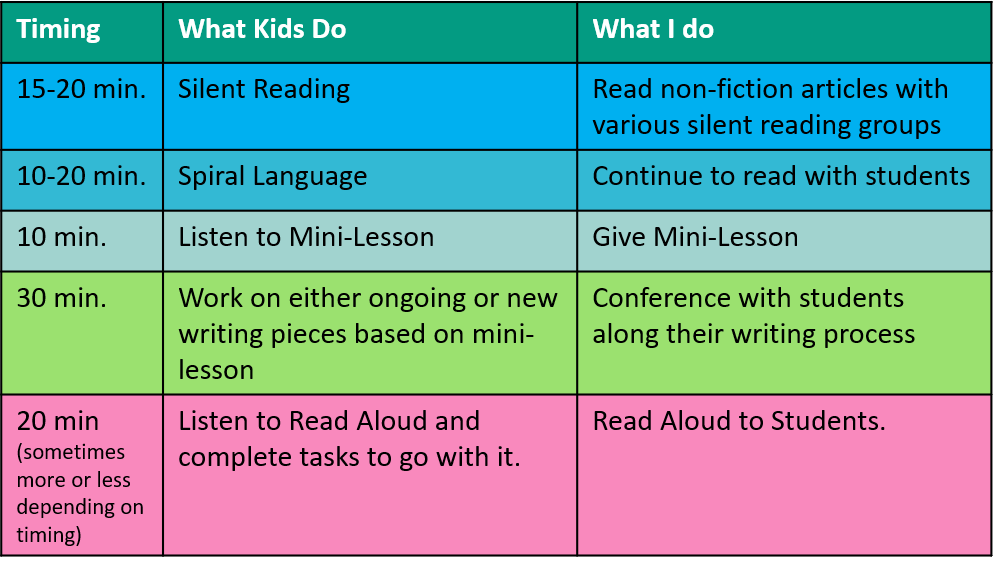
You might think that setting up a remote learning language block is a huge task. You aren’t wrong but then again, setting up any literacy block always seems like a huge task. However it doesn’t need to be one! Your remote learning block can be just as effective, and offer some time off screen, for your learners. Let me explain.
In my group we run a language block that offers some flexibility after students are used to routine. If you want to see more information about how I run my Literacy block and the items I use for it please see my Setting up a Literacy Program post. Students know that when they login they are to turn their screen on, find a book and read for about twenty minutes. I let them know the order of the breakout rooms ahead of time and they meet me in the breakout room to read every Monday. This, right there, this is what will save your sanity!
Mondays are a busy day in my literacy block. This is the day where the new article for the week is introduced. On this day, more than any other I read with all reading groups. On other days I am there to pull students I know need extra reading practice or help students with other tasks. I group my students in varying ways and it really depends on the class and the kids. Some years I group by ability levels. The next month I may change it if I want a particular group to focus on a specific comprehension strategy. However I group my students I read with that group on Mondays. On all the other days the students work on the tasks in the non-fiction articles rather than reading with me. Remember I said it will save your sanity? On all these other days you have some time to circulate between breakout rooms or help students (or drink your coffee). Some days the tasks are short (I do a longer writing lesson), and some days the tasks take longer (shorter lesson). While I’m reading the other students are busy silent reading. I truly believe in allowing students to read for pleasure so students are allowed to pick their own books. Sometimes I ask them to do a mini-response on their books but most often I want them to read for the sake of enjoyment. Yes, this requires trust that they are reading and not just flipping pages. In a bricks and mortar class you can see these things. I have decided that there are aspects of remote learning that are beyond my control. I can’t control whether they are doing what they say they are. I can control that I’m going to be there to help read with them.
When I read with students they take turns reading and I set out the order ahead. I know my students, if I know they aren’t going to be able to read the passage I change things up and ask them to partner read or read with a partner to me. I have also sent the article to students ahead of the week so they can practice with a parent if they wish. However, my non-fiction articles are often at a level where I find most students can be successful. I also allow them to ‘show off’ using a text reader like Google Read and Write if they need it.
I keep reading with different groups while students move away from silent reading after 20 minutes and begin their spiral language. This is a review of all things language – grammar, spelling, vocabulary, writing, inferencing, media etc. My students know well enough that if they finish their spiral language they should begin work on whatever writing piece we’ve started. When I’m done reading with all the groups I usually moderate some writing samples with them, or offer a mini-lesson. I wish I could tell you every mini lesson in writing but I think that wouldn’t be truthful of me. I look at their writing and notice a common problem. If half need punctuation help I do a mini-lesson on punctuation. If what they really need is help with juicy adjectives then we do that! It really depends on what they need. It’s based on their work and common mistakes or issues. Then they work on an ongoing writing piece. I stay in the meet so they can conference if need be but it’s very hands-off at this point (I have grade 6).
While sometimes this writing goes on more than thirty minutes we begin a read-aloud task roughly 30 minutes after the students start working on writing. Sometimes I have them listen and make notes in an ongoing notebook. For example in the book Space Case my students are require to keep a ‘detective log‘ of the suspects and why they consider them a suspect. It’s fun and easy and they don’t realize I’m making them inference. Please don’t tell them!
As I tell my principal all the time, my literacy block isn’t perfect but it runs well, the kids are engaged and I get to hear every student read at least once a week.